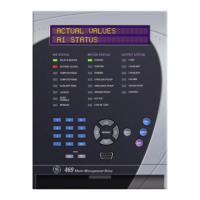2 469 MOTOR MANAGEMENT RELAY – COMMUNICATIONS GUIDE
MODBUS PROTOCOL COMMUNICATIONS GUIDE
The 469 is always a slave. It cannot be programmed as a master. Computers or PLCs are
commonly programmed as masters. The Modbus protocol exists in two versions: Remote
Terminal Unit (RTU, binary) and ASCII. Only the RTU version is supported by the 469.
Monitoring, programming and control functions are possible using read and write register
commands.
Data Frame Format and Data Rate
One data frame of an asynchronous transmission to or from an 469 is default to 1 start bit,
8 data bits, and 1 stop bit. This produces a 10 bit data frame. This is important for
transmission through modems at high bit rates (11-bit data frames are not supported by
Hayes modems at bit rates of greater than 300 bps). The parity bit is optional as odd or
even. If it is programmed as odd or even, the data frame consists of 1 start bit, 8 data bits,
1 parity bit, and 1 stop bit.
Modbus protocol can be implemented at any standard communication speed. The 469
RS485/RS232 ports support operation at 1200, 2400, 4800, 9600, and 19200 baud.
Data Packet Format
A complete request/response sequence consists of the following bytes (transmitted as
separate data frames):
• SLAVE ADDRESS: This is the first byte of every transmission. This byte represents the
user-assigned address of the slave device that receives the message sent by the
master. Each slave device must be assigned a unique address and only the addressed
slave responds to a transmission that starts with its address. In a master request
transmission the Slave Address represents the address of the slave to which the
request is being sent. In a slave response transmission the Slave Address represents
the address of the slave that is sending the response. Note that a master transmission
with a Slave Address of 0 indicates a broadcast command. Broadcast commands can
be used for specific functions.
• FUNCTION CODE: This is the second byte of every transmission. Modbus defines
function codes of 1 to 127. The 469 implements some of these functions. In a master
request transmission the Function Code tells the slave what action to perform. In a
slave response transmission if the Function Code sent from the slave is the same as
the Function Code sent from the master indicating the slave performed the function
as requested. If the high order bit of the Function Code sent from the slave is a 1 (i.e. if
the Function Code is > 127) then the slave did not perform the function as requested
and is sending an error or exception response.
MASTER QUERY MESSAGE:
SLAVE ADDRESS: (1 byte)
FUNCTION CODE: (1 byte)
DATA: (variable number of bytes depending on FUNCTION CODE)
CRC: (2 bytes)
SLAVE RESPONSE MESSAGE:
SLAVE ADDRESS: (1 byte)
FUNCTION CODE: (1 byte)
DATA: (variable number of bytes depending on FUNCTION CODE)
CRC: (2 bytes)

